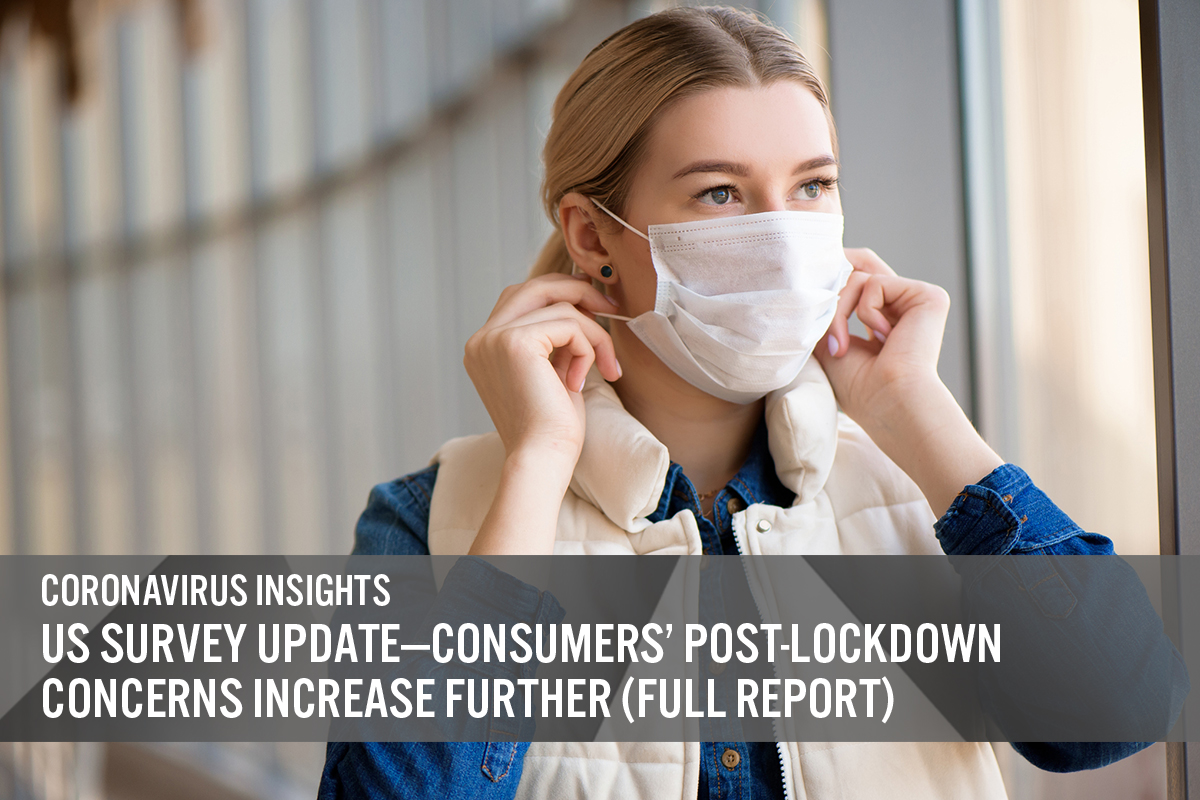
DIpil Das
Introduction
This report presents the results of Coresight Research’s latest weekly survey of US consumers on the coronavirus outbreak, undertaken on April 29. This report explores the trends we are seeing from week to week, following prior surveys on April 22, April 15, April 8, April 1, March 25 and March 17–18.Looking Beyond Lockdown
Half of US Consumers Expect To Avoid Shopping Centers As the easing of lockdowns gets closer, consumers appear to be becoming more concerned about returning to public places. This week, almost three-quarters of respondents said they expect to continue avoiding some kinds of public places or change some travel arrangements after lockdowns end—up significantly from around two-thirds last week. Half of all consumers expect to avoid shopping centers/malls after lockdown. Our survey found that shops in general are expected to be much less avoided, reflecting the need for consumers to shop for essentials, more often in off-mall locations. As we have previously noted, our survey data could imply that the crisis will have more lasting impacts for traditional malls than for other types of retail locations. Shoppers may perceive off-mall centers, such as open-air centers, as safer—and these types of centers are also likely to benefit from the preponderance of nondiscretionary retailers such as supermarkets, versus the discretionary focus of enclosed malls. Of the 14 types of locations and travel options we provided to respondents, 11 saw an uptick of over five percentage points versus last week. [caption id="attachment_108852" align="aligncenter" width="700"] Respondents could select multiple options
Respondents could select multiple options Base: US Internet users aged 18+
Source: Coresight Research [/caption] Consumers Put Timescales on the Recovery We asked three questions in which respondents were required to estimate the timescale of coronavirus impacts.
- We asked those respondents who expect to take avoidance action how long they expect to be doing so for.
- We asked those making fewer or more purchases of any categories how long they expect it will be before their spending bounces back to normal levels.
- We asked all respondents how long they think the severe effects of the outbreak will impact life in the US.
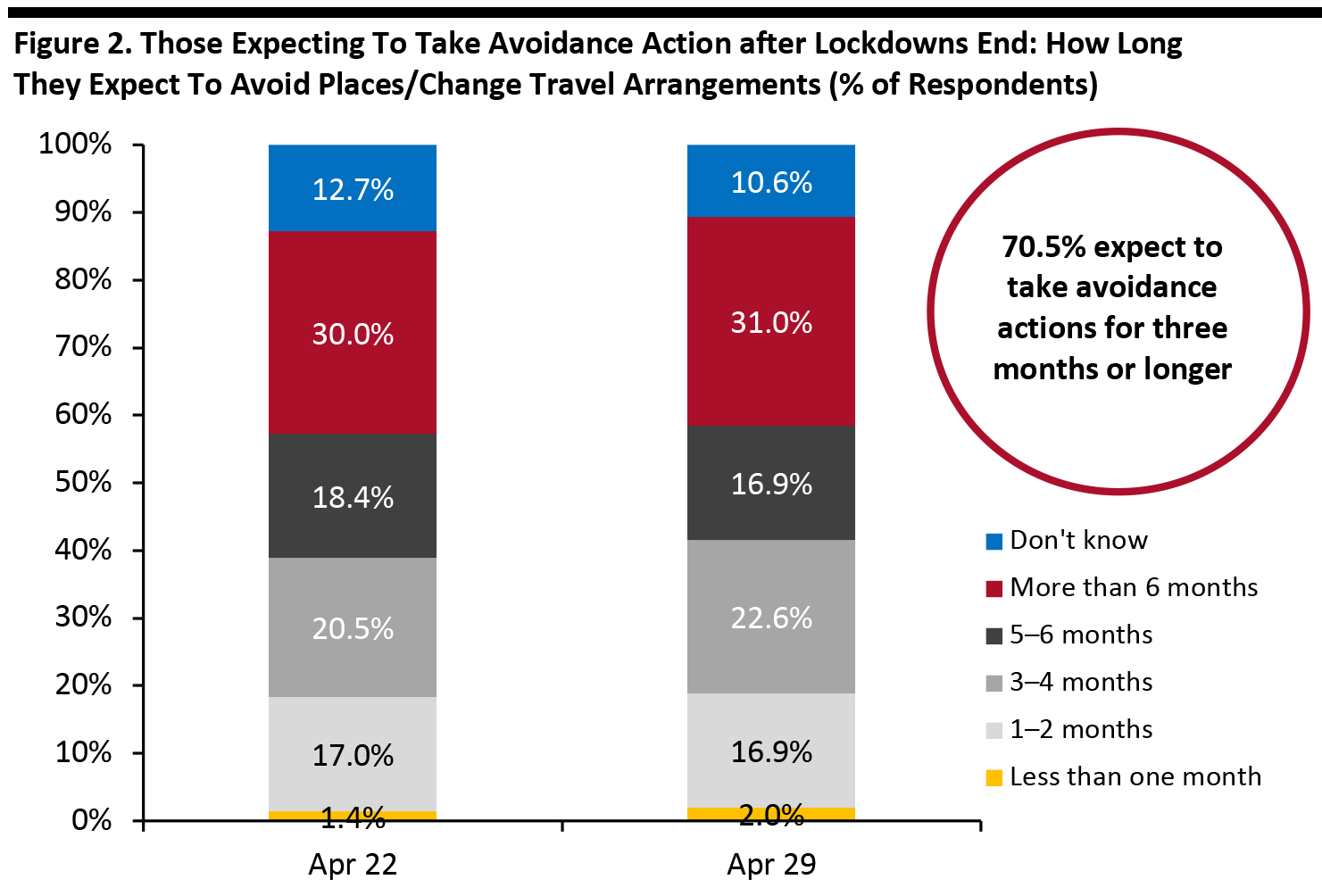 Base: US Internet users aged 18+ who expect to avoid places/change travel arrangements after lockdowns end
Base: US Internet users aged 18+ who expect to avoid places/change travel arrangements after lockdowns end Source: Coresight Research [/caption] Spending Bounce Back: One-Quarter Expect To Retain Changed Spending Patterns for More Than Six Months Among those who have changed their spending levels—either buying more or less of any categories—around one-quarter expect it to be more than six months before their spending patterns return to normal. We see a broadly similar pattern when we focus only on those making fewer purchases: 25.1% of this group expect to return to pre-crisis spending patterns only in more than six months’ time (Figure 4).
- We show what consumers are buying more of and less of in a separate section, later in this report.
 Base: US Internet users aged 18+ who are purchasing any products more or less, because of the coronavirus outbreak
Base: US Internet users aged 18+ who are purchasing any products more or less, because of the coronavirus outbreak Source: Coresight Research [/caption] [caption id="attachment_108855" align="aligncenter" width="700"]
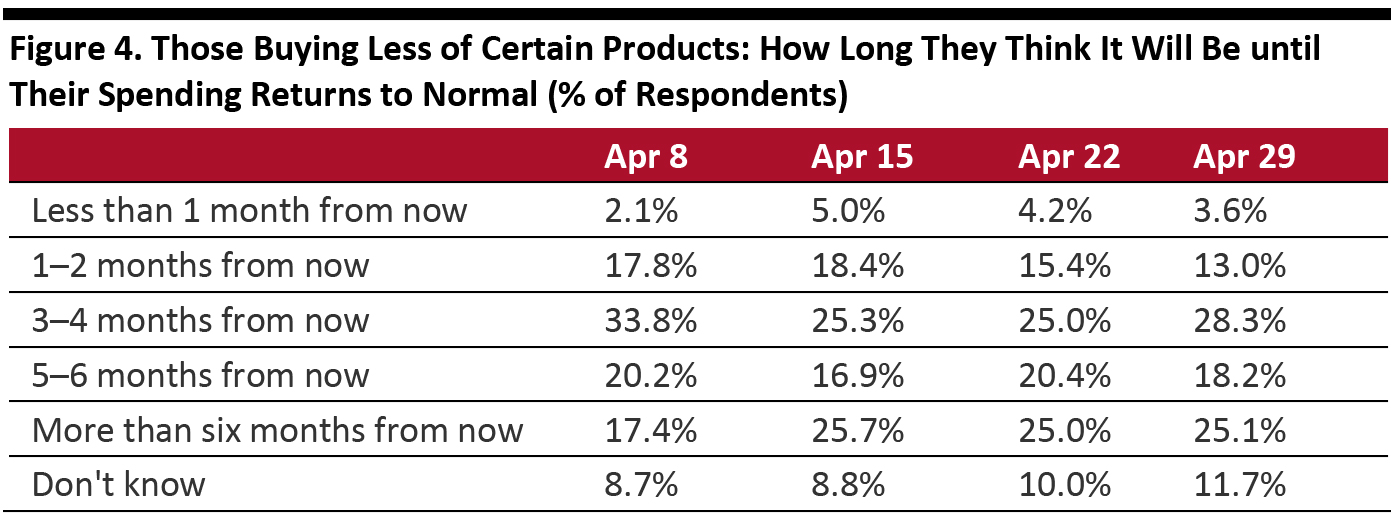 Base: US Internet users aged 18+ who are purchasing any products less, because of the coronavirus outbreak
Base: US Internet users aged 18+ who are purchasing any products less, because of the coronavirus outbreak Totals may not sum due to rounding
Source: Coresight Research [/caption] Impact on Everyday Life: Four in 10 Consumers Expect the Crisis To Last More Than Six Months This week, consumers’ expectations of the length of the crisis increased yet again. Some 41.3% now expect the severe impact of the outbreak to last more than six months from its start, up from 38.3% last week. This timescale implies that the severe impacts will run up to the holiday season. Some 87.3% expect the severe impact to last three months or more, broadly level with 87.8% last week. [caption id="attachment_108856" align="aligncenter" width="700"]
 Base: US Internet users aged 18+ *Not provided as an option after April 15
Base: US Internet users aged 18+ *Not provided as an option after April 15 Source: Coresight Research [/caption] Two-Thirds Expect To Retain Changed Behaviors for the Long Term Also looking ahead, we asked respondents whether they think they will keep some of the behaviors they have adopted during the coronavirus crisis. In recent weeks, this metric has leveled off at around two-thirds of all consumers expecting to retain some behaviors over the long term. [caption id="attachment_108857" align="aligncenter" width="700"]
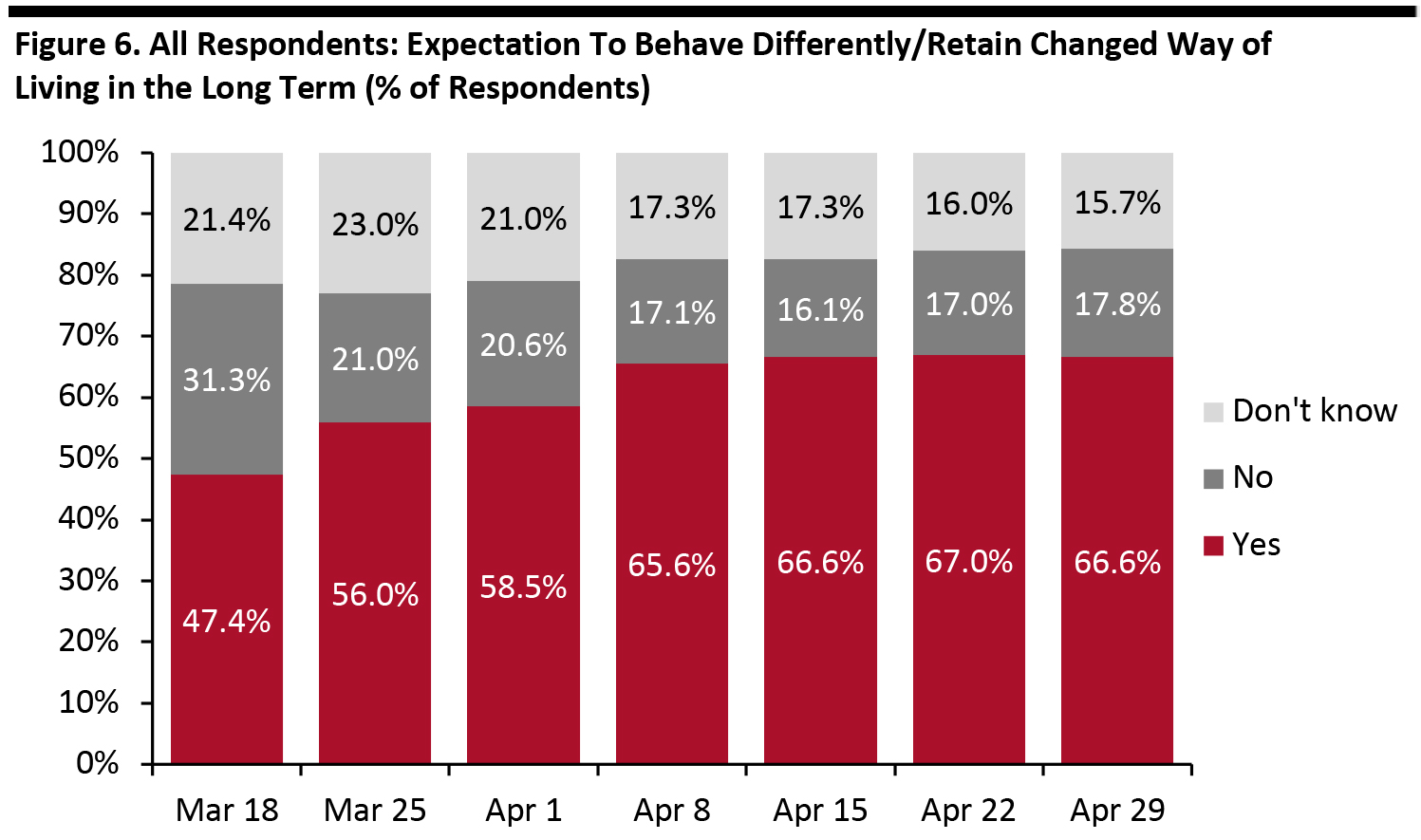 Base: US Internet users aged 18+
Base: US Internet users aged 18+ Source: Coresight Research [/caption] Among those expecting to retain behaviors, better hygiene practices have routinely been the number-one option. However, in recent weeks, less physical interaction has increased—likely reflecting a growing realization that post-lockdown normality will involve physical distancing. In retail, this will be reflected in the regulation of shopper numbers and social distancing in physical stores. This week, we saw a further incremental increase in two retail-specific metrics:
- The proportion of respondents expecting to switch retail purchases from stores to e-commerce rose from 41.4% of those expecting to retain changed behaviors last week to 43.6% this week.
- This week, 31.0% said they expect to shop less overall, versus 27.9% last week.
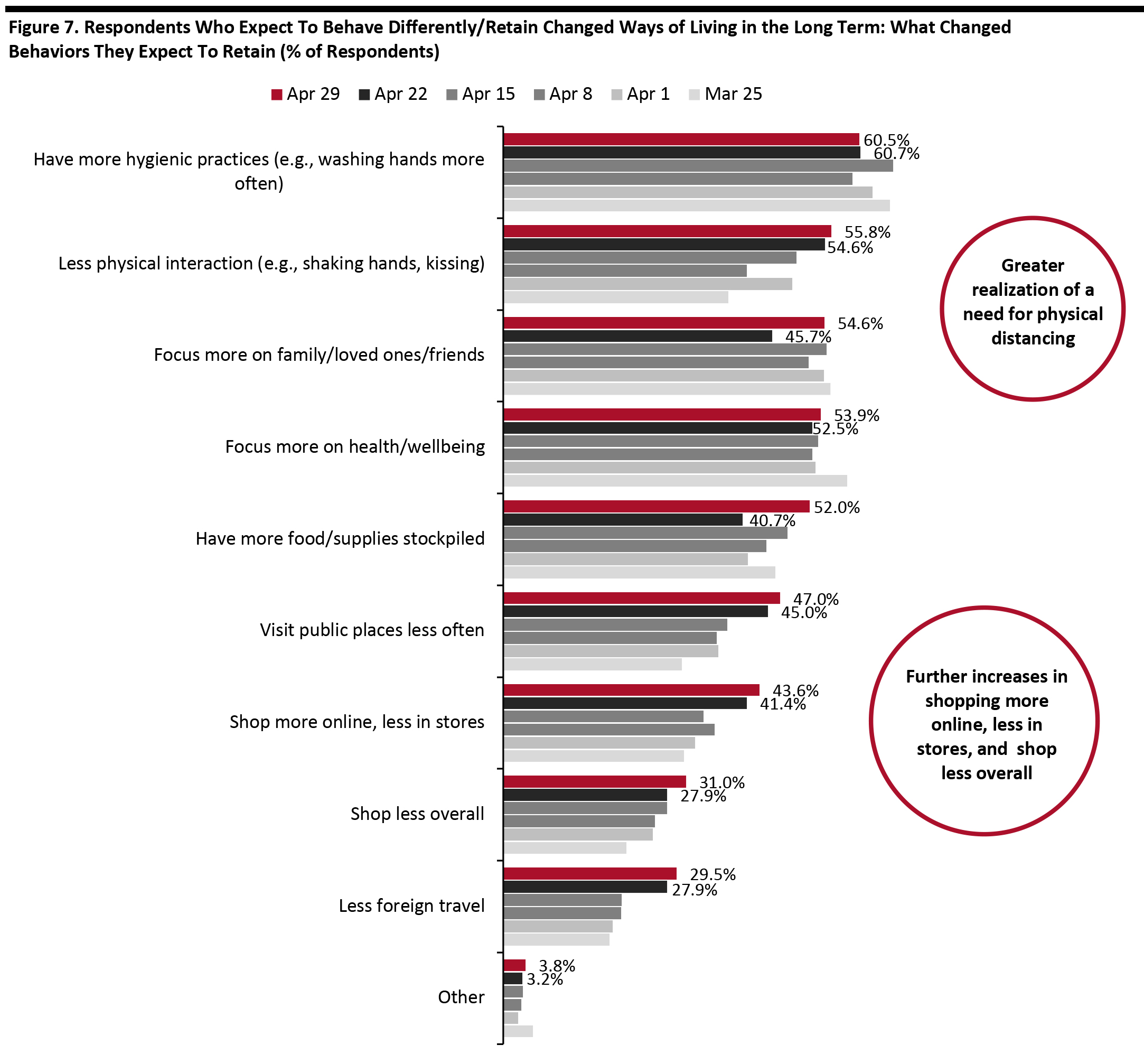 Respondents could select multiple options
Respondents could select multiple options Base: US Internet users aged 18+ who expect to behave differently in the long term/retain changed ways of living from the outbreak
Source: Coresight Research [/caption] In the chart below, we focus on trending data in two of the metrics charted above. We represent these as a proportion of all respondents, to represent consumers overall, rather than as a proportion of those expecting to retain changed behaviors (a subset that is growing). Rebased to all respondents, the upward trend is more distinct: Almost 30% of all consumers now expect to shop more online and less in store, up almost 13 percentage points in the space of six weeks. Perhaps more alarmingly for retail, one in five of all consumers now expect to shop less overall. [caption id="attachment_108859" align="aligncenter" width="700"]
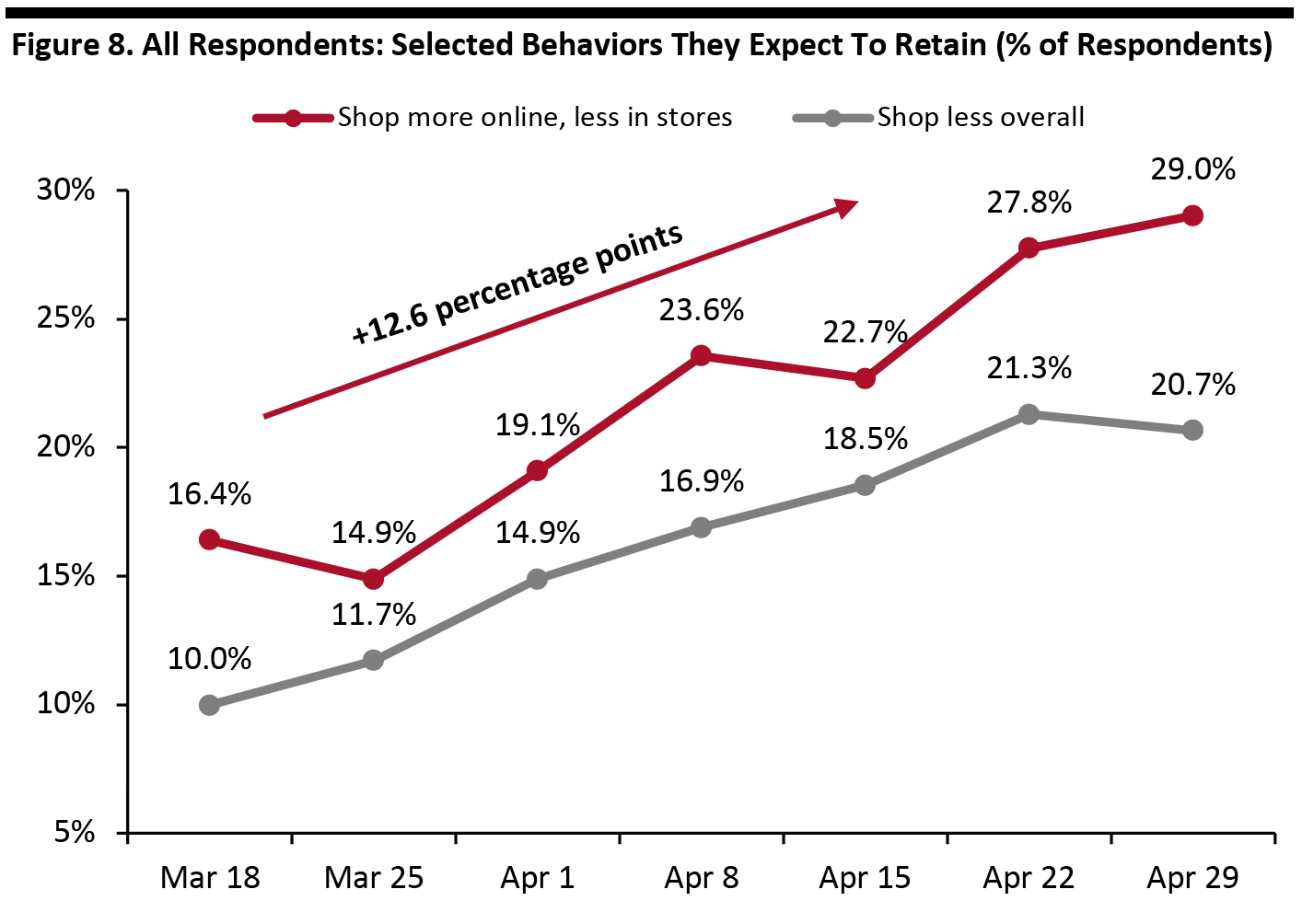 Base: US Internet users aged 18+
Base: US Internet users aged 18+ Source: Coresight Research [/caption]
Reviewing Trend Data in Purchasing Behavior
What Consumers Are Buying More Of and Less Of This week, we saw a rebound in the proportion of respondents buying more of any category, to 71.8% from 64.6% last week. The proportion of respondents buying less remained more stable, at 64.1% this week versus 62.2% last week.- Note, buying more of certain categories and buying less of certain categories were not mutually exclusive options, so respondents could answer yes to both.
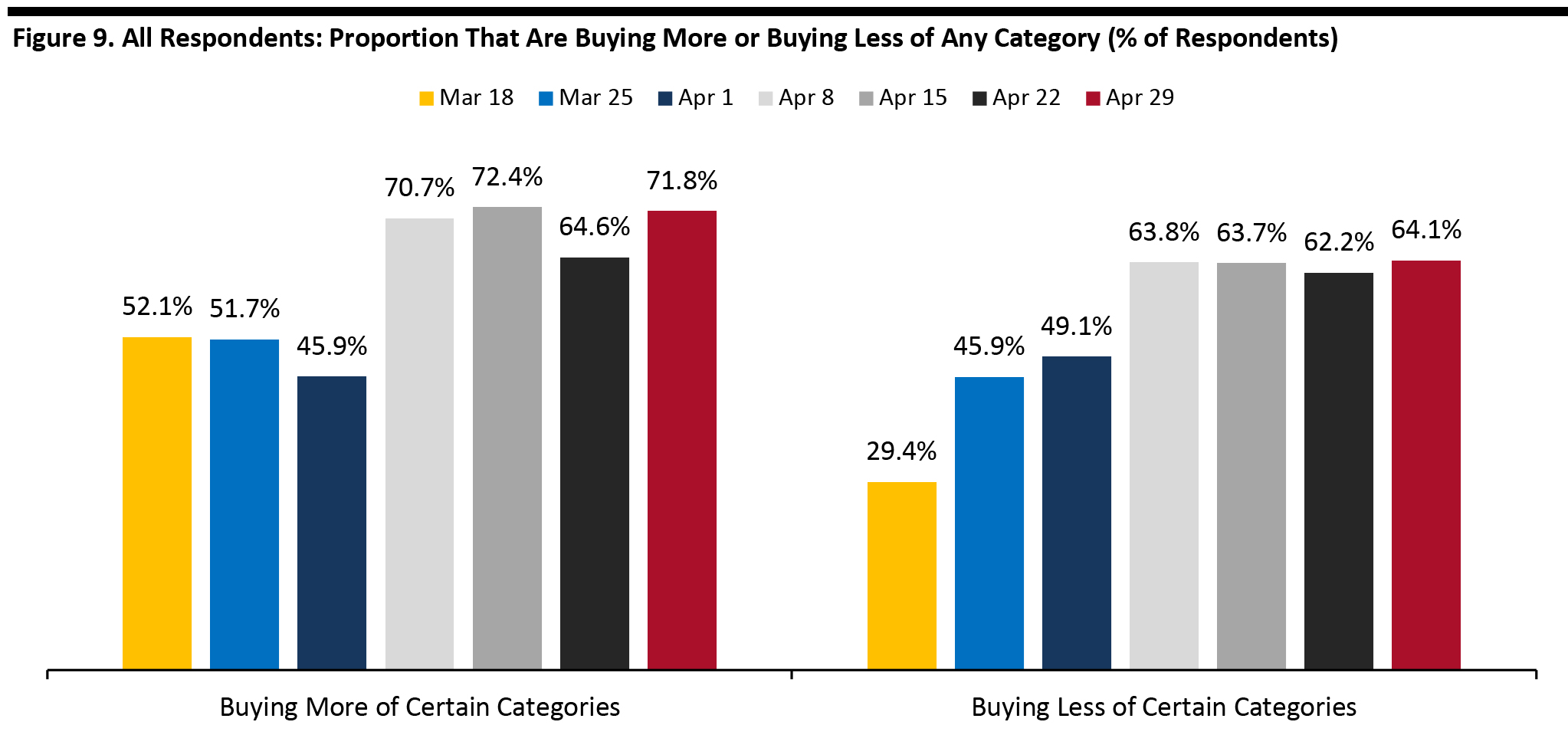 Base: US Internet users aged 18+
Base: US Internet users aged 18+ Source: Coresight Research [/caption] Buying more: Food and other essentials continue to be net beneficiaries, and consumers continue to turn to media products and streaming. Buying less: Apparel continues to be the number-one category for cutbacks, and we saw a second week of increases in the proportion of respondents saying they are buying less, after a trough at 35.9% in our April 15 survey. Furniture/home and beauty and furniture remained the next-most-cut categories, but while the proportion cutting beauty purchases was stable, week over week, the proportion cutting furniture/home purchases increased versus last week. We break out week-over-week trend data for selected categories in Figure 11. Ratio of less to more: The ratio of those purchasing less to those purchasing more for clothing and footwear stood at 5.2 this week versus 5.4 last week. The ratio for furniture, furnishings and home improvement was level, week over week, at 4.5. Beauty products stood at 3.4 this week, versus 3.7 last week. [caption id="attachment_108861" align="aligncenter" width="700"]
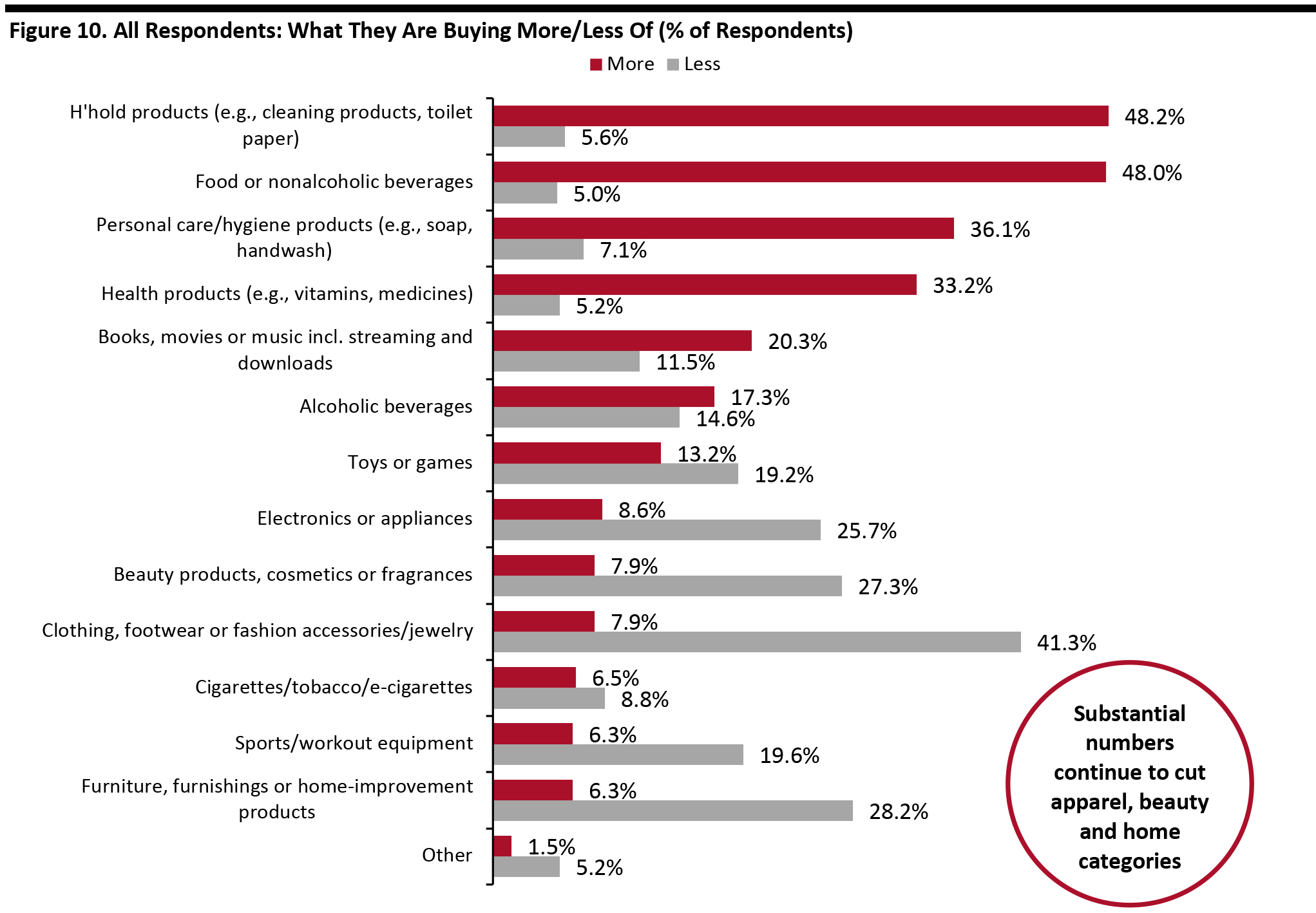 Respondents could select multiple options
Respondents could select multiple options Base: US Internet users aged 18+
Source: Coresight Research [/caption] [caption id="attachment_108862" align="aligncenter" width="700"]
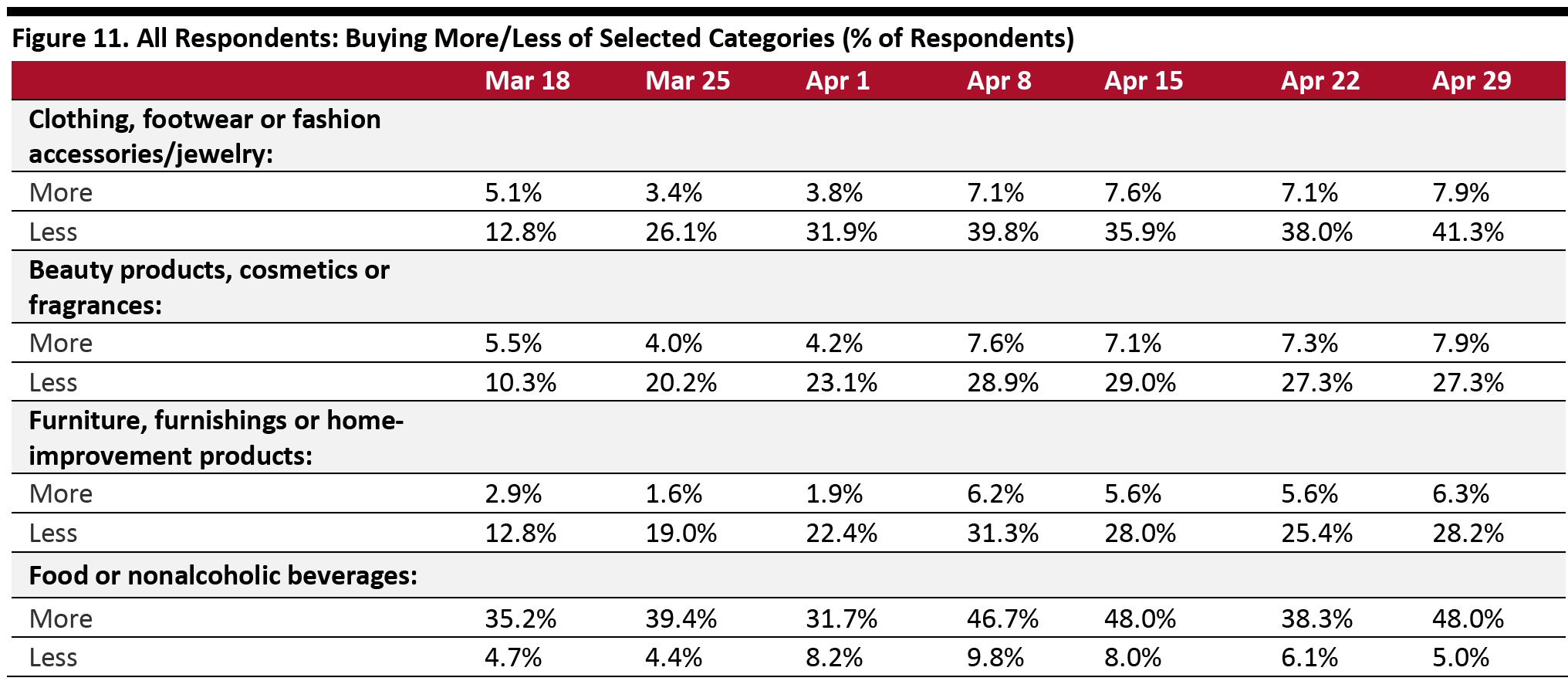 Base: US Internet users aged 18+
Base: US Internet users aged 18+ Source: Coresight Research [/caption] Two-Thirds Are Switching Spending Online The proportion of consumers switching spend to e-commerce has leveled off at just under two-thirds. [caption id="attachment_108863" align="aligncenter" width="700"]
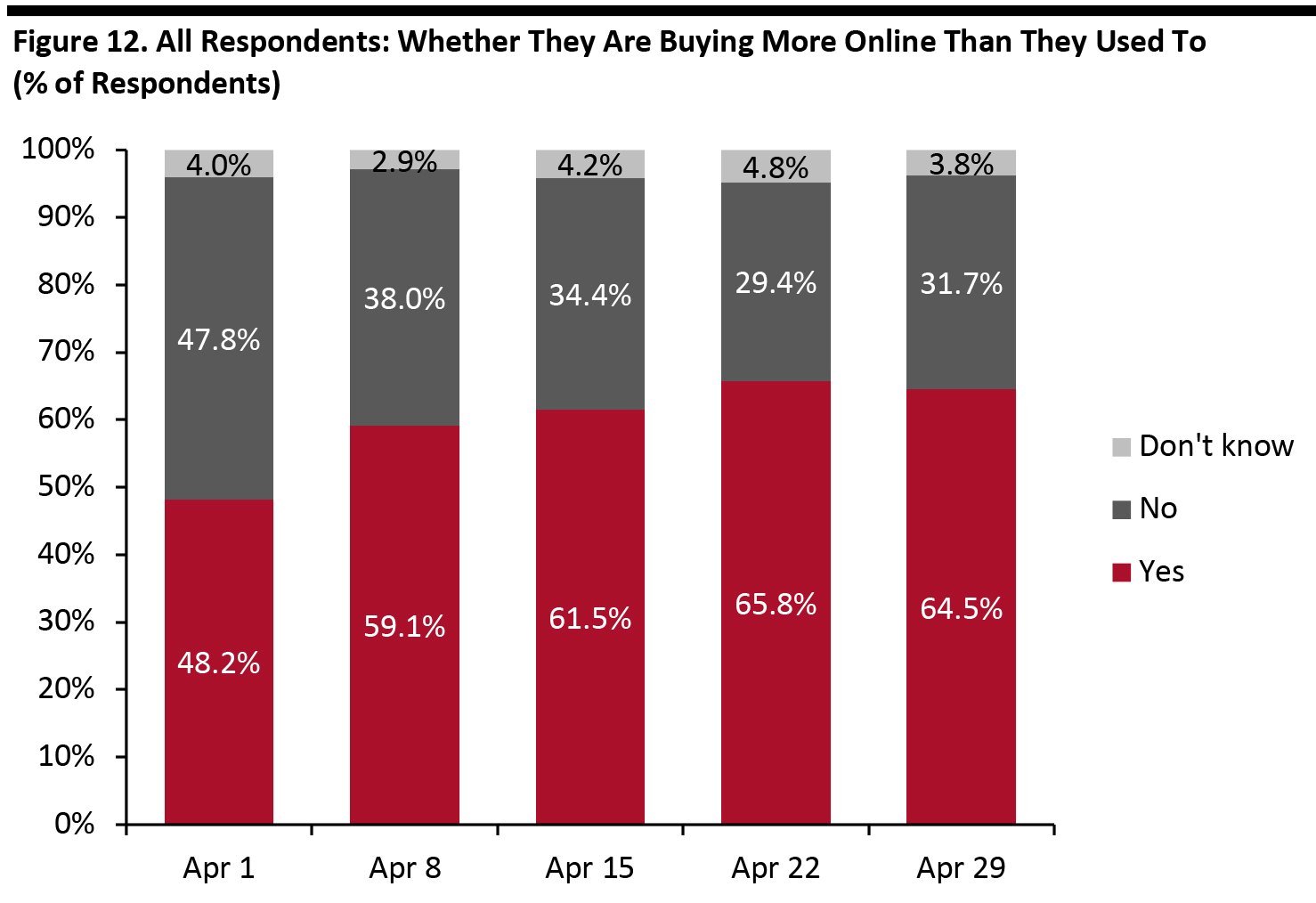 Base: US Internet users aged 18+
Base: US Internet users aged 18+ Source: Coresight Research [/caption] What They Are Buying More Of Online Among the respondents making more purchases online, we saw everyday household products and health products continue to fall back—likely reflecting many consumers turning to their stockpiled supplies. We saw an increase in the proportion buying more clothing or footwear online—the general trend is for this metric to increase. Remember, the figures below are a proportion of those who are buying more online in general. Considered as a proportion of all respondents (representing consumers in general), buying more apparel online stood at 15.9% this week, versus 14.1% last week. [caption id="attachment_108864" align="aligncenter" width="700"]
 Respondents could select multiple options
Respondents could select multiple options Base: US Internet users aged 18+ who make more purchases online than they did before the coronavirus outbreak
Source: Coresight Research [/caption]
Shoppers’ Concerns about Jobs and Income
We asked respondents to choose from a selection of statements related to employment and income. Around one in nine says they have lost their job. This week, a total of 42.0% were worried about losing their job or part of their income, versus 39.2% last week. [caption id="attachment_108865" align="aligncenter" width="700"] Base: US Internet users aged 18+
Base: US Internet users aged 18+ Source: Coresight Research [/caption]